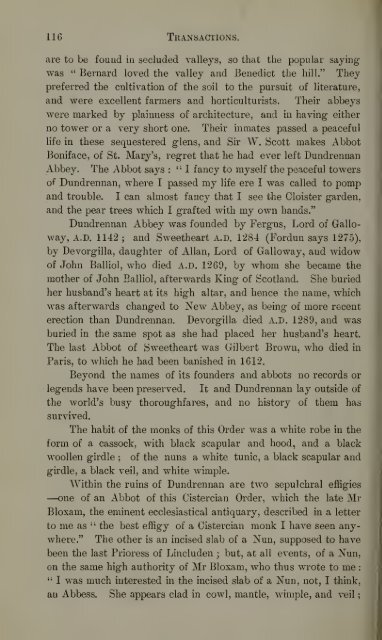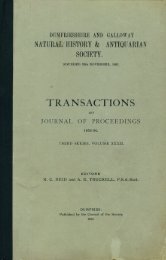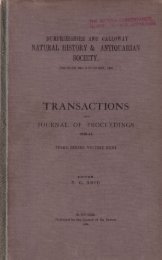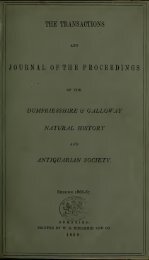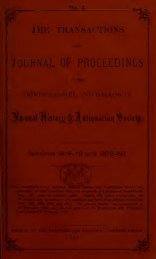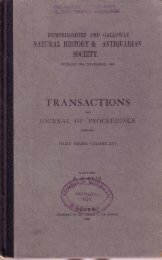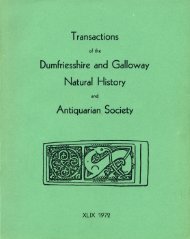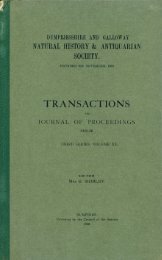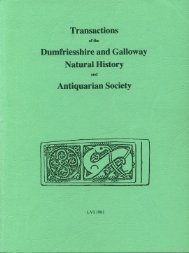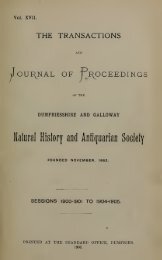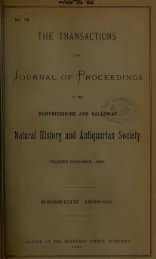Vol 10 - Dumfriesshire & Galloway Natural History and Antiquarian ...
Vol 10 - Dumfriesshire & Galloway Natural History and Antiquarian ...
Vol 10 - Dumfriesshire & Galloway Natural History and Antiquarian ...
You also want an ePaper? Increase the reach of your titles
YUMPU automatically turns print PDFs into web optimized ePapers that Google loves.
116 Transactions.are to be found in secluded valleys, so that the popular sayingwas " Bernard loved the valley <strong>and</strong> Benedict the hill." Theypreferred the cultivation of the soil to the pursuit of literature,<strong>and</strong> were excellent farmers <strong>and</strong> horticulturists. Their abbeyswere marked by plainness of architecture, <strong>and</strong> in having- eitherno tower or a very short one. Their inmates passed a peacefullife in these sequestered glens, <strong>and</strong> Sir W. JScott makes AbbotBoniface, of St. Mary's, regret that he had ever left DundrennanAbbey. The Abbot says :" I fancy to myself the peaceful towersof Dundrennan, where I passed m}^ life ere I was called to pomp<strong>and</strong> trouble. I can almost fancy that I see the Cloister garden,<strong>and</strong> the pear trees which I grafted with my own h<strong>and</strong>s."Dundrennan Abbey was founded by Fergus, Lord of <strong>Galloway</strong>,A.D. 1142 ; <strong>and</strong> Sweetheart A.D. 1284 (Fordun says 1275),by Devorgilla, daughter of Allan, Lord of <strong>Galloway</strong>, <strong>and</strong> widowof John Balliol, who died A.D. 1269, by whom she became themother of John Balliol, afterwards King of Scotl<strong>and</strong>.She buriedher husb<strong>and</strong>'s heart at its high altar, <strong>and</strong> hence the name, whichwas afterwards changed to New Abbey, as being of more recenterection than Dundrennan. Devorgilla died A.D. 1289, <strong>and</strong> wasburied in the same spot as she had placed her husb<strong>and</strong>'s heart.The last Abbot of Sweetheart was Gilbert Brown, who died inParis, to which he had been banished in 1612.Beyond the names of its founders <strong>and</strong> abbots no records or•legends have been preserved. It <strong>and</strong> Dundrennan lay outside ofthe world's busy thoroughfares, <strong>and</strong> no history of them hassurvived.The habit of the monks of this Order was a white robe in theform of a cassock, with black scapular <strong>and</strong> hood, <strong>and</strong> a blackwoollen girdle ; of the nuns a white tunic, a black scapular <strong>and</strong>girdle, a black veil, <strong>and</strong> white wimple.Within the ruins of Dundrennan are two sepulchral effigies—one of an Abbot of this Cistercian Order, which the late MrBloxam, the eminent ecclesiastical antiquary, describedin a letterto me as " the best effigy of a Cistercian monk I have seen anywhere."The other is an incised slab of a Nun, supposed to havebeen the last Prioress of Lincluden ; but, at all events, of a Nun,on the same high authority of Mr Bloxam, who thus wrote to me :" I was much interested in the incised slab of a Nun, not, I think,an Abbess. She appears clad in cowl, mantle, wimple, <strong>and</strong> veil


